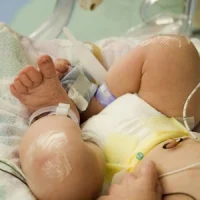A Neonatal Intensive Care Unit (NICU) at UC San Diego Health in the U.S. has introduced a monitoring technology to detect when infants are at risk of infection.
The Heart Rate Observation system (HeRO) (MPSC, Charlottesville, USA) is an algorithm-based system that can detect slight changes in a baby’s heartbeat that could be an early sign of a major infection in the blood stream and intestines, such as sepsis.
“The challenge with diagnosing sepsis is a lot of symptoms for the early stages of the infection are subtle and nonspecific,” said Erika Fernandez, MD, director of the NICU at UC San Diego Health. “With the HeRO technology, we can detect symptoms of sepsis up to 24 hours before the infection actually happens. This allows us to begin an investigation and intervene with treatment before a baby becomes critically ill.”
See Also: MSSA More Common than MRSA in NICUs
The HeRO system reports vital sign trends much earlier than the human eye or traditional equipment and requires no additional wiring to the baby, so mothers can breastfeed without worrying about the equipment. The system uses a zero-to-seven surveillance score generated after a heart rate is analysed, with anything higher than a two considered an alert for possible infection.
Lawrence Prince, MD, PhD, chief in the Division of Neonatology at UC San Diego Health said: “It makes for a much less intimidating experience for families and a highly improved monitoring approach for medical staff."
Source and image credit: University of California, San Diego Health Sciences
Image: Melissa Renteria holds her newborn baby, Arthur, while he's monitored by the HeRO technology.
The Heart Rate Observation system (HeRO) (MPSC, Charlottesville, USA) is an algorithm-based system that can detect slight changes in a baby’s heartbeat that could be an early sign of a major infection in the blood stream and intestines, such as sepsis.
“The challenge with diagnosing sepsis is a lot of symptoms for the early stages of the infection are subtle and nonspecific,” said Erika Fernandez, MD, director of the NICU at UC San Diego Health. “With the HeRO technology, we can detect symptoms of sepsis up to 24 hours before the infection actually happens. This allows us to begin an investigation and intervene with treatment before a baby becomes critically ill.”
See Also: MSSA More Common than MRSA in NICUs
The HeRO system reports vital sign trends much earlier than the human eye or traditional equipment and requires no additional wiring to the baby, so mothers can breastfeed without worrying about the equipment. The system uses a zero-to-seven surveillance score generated after a heart rate is analysed, with anything higher than a two considered an alert for possible infection.
Lawrence Prince, MD, PhD, chief in the Division of Neonatology at UC San Diego Health said: “It makes for a much less intimidating experience for families and a highly improved monitoring approach for medical staff."
Source and image credit: University of California, San Diego Health Sciences
Image: Melissa Renteria holds her newborn baby, Arthur, while he's monitored by the HeRO technology.
Latest Articles
Technology Detects Risk of Infection in Premature or Critically Ill Infants
Infants, NICU, Monitoring, Infection










